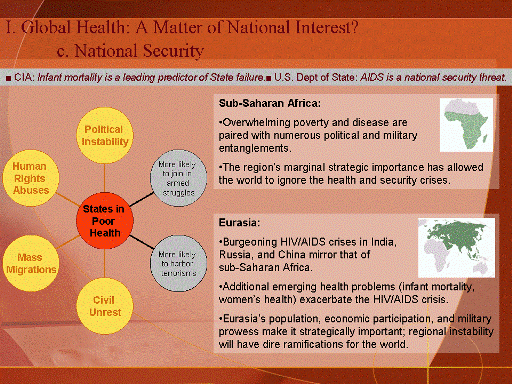| front |1 |2 |3 |4 |5 |6 |7 |8 |9 |10 |11 |12 |13 |14 |15 |16 |17 |18 |19 |20 |21 |22 |23 |24 |25 |26 |27 |28 |review |
 |
C. National Security
Extremely poor health in
other parts of the world can also affect the security of the United
States and its allies. Research shows a correlation between health
and the effective functioning of government and civil society. The
CIA, for example, finds that high infant mortality is a leading
predictor of State failure, and the State Department called AIDS a
national security threat. States with exceptionally unhealthy
populations are often in crisis, fragmented, and governed poorly. In
its most extreme form, poor health can contribute to political
instability, civil unrest, mass migrations, and human rights abuses.
In these States, there is greater opportunity to harbor terrorists
or recruit disaffected people to join in armed struggles.
Politically unstable States require heightened diplomacy, create
political entanglements, and sometimes provoke military responses.
Diseases of poverty
overwhelming are concentrated in sub-Saharan Africa, and it is no
surprise that many of these political and military entanglements
occur in that region. The rest of the world, however, has largely
been insulated from the devastation wrought by these endemic
diseases. The explanation for this “awful dissonance” may lie in the
region’s marginal strategic importance. Sub-Saharan Africa has weak
political, military, and economic power.
The same cannot be said
about the burgeoning health crises emerging in pivotal countries in
Eurasia, such as China, India, and Russia. These countries are in
the midst of a “second wave” of HIV/AIDS, which mirrors the earlier
explosion in Sub-Saharan Africa. The HIV prevalence in the Ukraine
and the Russian Federation, for example, have risen twenty-fold in
less than a decade. In the decades ahead, the center of the global
HIV/AIDS pandemic is projected to shift from Africa to Eurasia.
The HIV/AIDS crisis in
Eurasia is exacerbated by additional emerging health problems.
Recall that infant mortality is a prime predictor of State
instability. Russia’s official infant mortality rate (which is
thought to be vastly under-reported) is 3-4 times higher than in
North America and Western Europe, and similar levels are found in
parts of India and China. Of children who are born alive, nearly
two-thirds will be unhealthy, many suffering lifelong illness and
disability. Women’s reproductive health is also poor, with nearly
half of all pregnant women being malnourished and sick, many losing
their babies before term.
Eurasia is a region of high
strategic importance in terms of its population, economic and
military prowess, and political influence. It has more than 60% of
the world’s inhabitants; one of the highest combined GNPs; and at
least four massive armed forces with nuclear capabilities. But due
to extreme health hazards, Eurasia will suffer economic, political,
and military decline. Political instability in a region with such
geostrategic importance will have major international ramifications.
|